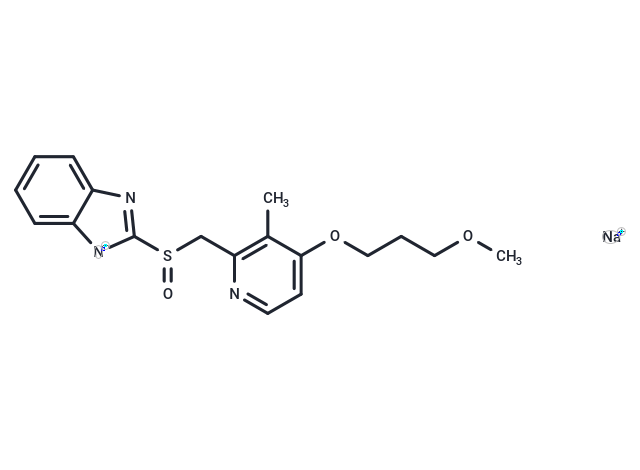Shopping Cart
Remove All Your shopping cart is currently empty
Your shopping cart is currently empty
Rabeprazole sodium (Habeprazole Sodium) is a 4-(3-methoxypropoxy)-3-methylpyridinyl derivative of timoprazole that is used in the therapy of stomach ulcers and Zollinger-Ellison syndrome. The drug inhibits H(+)-K(+)-exchanging ATPase which is found in gastric parietal cells.

| Pack Size | Price | USA Warehouse | Global Warehouse | Quantity |
|---|---|---|---|---|
| 10 mg | $35 | - | In Stock | |
| 25 mg | $61 | - | In Stock | |
| 50 mg | $87 | - | In Stock | |
| 100 mg | $123 | Inquiry | Inquiry | |
| 200 mg | $179 | Inquiry | Inquiry | |
| 1 mL x 10 mM (in DMSO) | $29 | - | In Stock |
| Description | Rabeprazole sodium (Habeprazole Sodium) is a 4-(3-methoxypropoxy)-3-methylpyridinyl derivative of timoprazole that is used in the therapy of stomach ulcers and Zollinger-Ellison syndrome. The drug inhibits H(+)-K(+)-exchanging ATPase which is found in gastric parietal cells. |
| Targets&IC50 | UNH:0.3 μM (IC50) |
| In vitro | Administration of rabeprazole leads to a marked decrease in the viability of MKN-28 cells. Exposure to rabeprazole induces significant apoptosis in AGS cells. Rabeprazole completely inhibits the phosphorylation of ERK 1/2 in the MKN-28 cells, whereas the same effect is not observed in either the KATO III or MKN-45 cells. Rabeprazole is able to efficaciously inhibit the phosphorylation of ERK 1/2 in the gastric cancer cells.Thus, rabeprazole can attenuate the cell viability of human gastric cancer cells through inactivation of the ERK1/2 signaling pathway[2]. |
| In vivo | Rabeprazole does not appear to exacerbate bone metabolic disorders in gastrectomized rats, but rather ameliorates the TG-induced BMD decrease[1]. |
| Cell Research | Rabeprazole is administrated to three gastric cancer cell lines, KATO III, MKN-28 and MKN-45, at a dosage of 0.2 mM for 16 h. The viability of these cells is determined by a trypan blue exclusion assay.(Only for Reference) |
| Synonyms | Rebeprazole sodium, LY307640 sodium, Habeprazole Sodium, Dexrabeprazole Sodium, Aciphex Sodium |
| Molecular Weight | 381.42 |
| Formula | C18H20N3NaO3S |
| Cas No. | 117976-90-6 |
| Smiles | c12c([n-]c(n1)S(=O)Cc1c(c(ccn1)OCCCOC)C)cccc2.[Na+] |
| Relative Density. | 0.45~0.55 g/ml |
| Color | White |
| Appearance | Solid |
| Storage | store at low temperature | Powder: -20°C for 3 years | In solvent: -80°C for 1 year | Shipping with blue ice/Shipping at ambient temperature. | ||||||||||||||||||||||||||||||||||||||||
| Solubility Information | DMSO: 58.82 mg/mL (154.21 mM), Sonication is recommended. H2O: 1.34 mg/mL (3.51 mM), Sonication is recommended. Ethanol: 71 mg/mL (186.15 mM), Sonication is recommended. | ||||||||||||||||||||||||||||||||||||||||
| In Vivo Formulation | 10% DMSO+40% PEG300+5% Tween 80+45% Saline: 2 mg/mL (5.24 mM), Sonication is recommended. Please add the solvents sequentially, clarifying the solution as much as possible before adding the next one. Dissolve by heating and/or sonication if necessary. Working solution is recommended to be prepared and used immediately. The formulation provided above is for reference purposes only. In vivo formulations may vary and should be modified based on specific experimental conditions. | ||||||||||||||||||||||||||||||||||||||||
Solution Preparation Table | |||||||||||||||||||||||||||||||||||||||||
H2O/DMSO/Ethanol
DMSO/Ethanol
| |||||||||||||||||||||||||||||||||||||||||
| Size | Quantity | Unit Price | Amount | Operation |
|---|

Copyright © 2015-2025 TargetMol Chemicals Inc. All Rights Reserved.